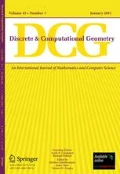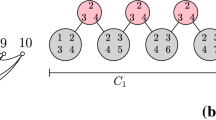Abstract
Let \(P\) be a set of \(n\) points in the plane. A crossing-free structure on \(P\) is a straight-edge plane graph with vertex set \(P\). Examples of crossing-free structures include triangulations and spanning cycles, also known as polygonalizations. In recent years, there has been a large amount of research trying to bound the number of such structures; in particular, bounding the number of (crossing-free) triangulations spanned by \(P\) has received considerable attention. It is currently known that every set of \(n\) points has at most O\((30^{n})\) and at least \(\Omega (2.43^{n})\) triangulations. However, much less is known about the algorithmic problem of counting crossing-free structures of a given set \(P\). In this paper, we develop a general technique for computing the number of crossing-free structures of an input set \(P\). We apply the technique to obtain algorithms for computing the number of triangulations, matchings, and spanning cycles of \(P\). The running time of our algorithms is upper-bounded by \(n^{\mathrm{O}(k)}\), where \(k\) is the number of onion layers of \(P\). In particular, for \(k = \hbox {O}(1)\) our algorithms run in polynomial time. Additionally, we show that our algorithm for counting triangulations in the worst case over all \(k\) takes time O\(^{*}(3.1414^{n})\). [In the notations \(\Omega ^{*}(\cdot ), \hbox {O}^{*}(\cdot )\), and \(\Theta ^{*}(\cdot )\), we neglect polynomial terms and we just present the dominating exponential term.] Given that there are several well-studied configurations of points with at least \(\Omega (3.47^{n})\) triangulations, and some even with \(\Omega (8.65^{n})\) triangulations, our algorithm asymptotically outperforms any enumeration algorithm for such instances. We also show that our techniques are general enough to solve the Restricted-Triangulation-Counting-Problem, which we prove to be \(W[2]\)-hard in the parameter \(k\). This implies that in order to be fixed-parameter tractable, our general algorithm must rely on additional properties that are specific to the considered class of crossing-free structures.





Similar content being viewed by others
Notes
\(f(\cdot )\) is log-concave iff \(f(\alpha x + (1 - \alpha )y)\ge f(x)^{\alpha } \cdot f(y)^{1 - \alpha }\) for every \(x,y\) in the domain of \(f\) and \(0\le \alpha \le 1\).
When we say “with high probability” we mean probability \(1-o(1)\).
References
Aichholzer, O.: The path of a triangulation. In: Proceedings of the 15th Annual Symposium on Computational Geometry, SoCG ’99, pp. 14–23. ACM Press, New York (1999)
Aichholzer, O., Krasser, H.: The point set order type data base: a collection of applications and results. In: Proceedings of the 13th Canadian Conference on Computational Geometry, CCCG ’01, pp. 17–20. Waterloo (2001)
Aichholzer, O., Hurtado, F., Noy, M.: A lower bound on the number of triangulations of planar point sets. Comput. Geom. 29(2), 135–145 (2004)
Aichholzer, O., Aurenhammer, F., Huemer, C., Vogtenhuber, B.: Gray code enumeration of plane straight-line graphs. Graphs Comb. 23(5), 467–479 (2007)
Aichholzer, O., Hackl, T., Huemer, C., Hurtado, F., Krasser, H., Vogtenhuber, B.: On the number of plane geometric graphs. Graphs Comb. 23(1), 67–84 (2007)
Ajtai, M., Chvátal, V., Newborn, M., Szemerédi, E.: Crossing-free subgraphs. In: Peter, G.S., Hammer, L., Rosa, A., Turgeon, J. (eds.) Theory and Practice of Combinatorics a Collection of Articles Honoring Anton Kotzig on the Occasion of His Sixtieth Birthday. North-Holland Mathematics Studies, vol. 60, pp. 9–12. North-Holland, Amsterdam (1982)
Alvarez, V., Seidel, R.: A simple aggregative algorithm for counting triangulations of planar point sets and related problems. In: Proceedings of the 29th Annual Symposium on Computational Geometry, SoCG ’13, pp. 1–8. ACM Press, New York (2013)
Alvarez, V., Bringmann, K., Curticapean, R., Ray, S.: Counting crossing-free structures. In: Proceedings of the 28th Annual Symposium on Computational Geometry, SoCG ’12, pp. 61–68. ACM Press, New York (2012)
Alvarez, V., Bringmann, K., Curticapean, R., Ray, S.: Counting triangulations and other crossing-free structures via onion layers. Computing Research Repository (CoRR) (2013). Available at http://arxiv.org/abs/1312.4628
Alvarez, V., Bringmann, K., Ray, S.: A simple sweep line algorithm for counting triangulations and pseudo-triangulations. Computing Research Repository (CoRR) (2013). Available at http://arxiv.org/abs/1312.3188
Alvarez, V., Bringmann, K., Ray, S., Seidel, R.: Counting triangulations and other crossing-free structures approximately. Comput. Geom. 48(5), 386–397 (2015)
Anagnostou, E., Corneil, D.: Polynomial-time instances of the minimum weight triangulation problem. Comput. Geom. 3(5), 247–259 (1993)
Auer, T., Held, M.: Heuristics for the generation of random polygons. In: Proceedings of the 8th Canadian Conference on Computational Geometry, CCCG ’96, pp. 38–43. (1996)
Avis, D., Fukuda, K.: Reverse search for enumeration. Discrete Appl. Math. 65(1–3), 21–46 (1996)
Bespamyatnikh, S.: An efficient algorithm for enumeration of triangulations. Comput. Geom. 23(3), 271–279 (2002)
Chew, L.P.: Constrained Delaunay triangulations. Algorithmica 4(1–4), 97–108 (1989)
Dalal, K.: Counting the onion. Random Struct. Algorithms 24(2), 155–165 (2004)
Demaine, E., Mitchell, J.S.B., O’Rourke, J.: Problem 16: Simple Polygonalizations. http://cs.smith.edu/~orourke/TOPP/P16.html#Problem.16 (2014). Accessed 12 May 2014
Dumitrescu, A., Schulz, A., Sheffer, A., Tóth, C.D.: Bounds on the maximum multiplicity of some common geometric graphs. SIAM J. Discrete Math. 27(2), 802–826 (2013)
Flajolet, P., Noy, M.: Analytic combinatorics of non-crossing configurations. Discrete Math. 204(1–3), 203–229 (1999). Selected papers in honor of Henry W. Gould
Flum, J., Grohe, M.: Parameterized Complexity Theory. Texts in Theoretical Computer Science. An EATCS Series. Springer, Berlin (2006)
García, A., Noy, M., Tejel, J.: Lower bounds on the number of crossing-free subgraphs of \({K}_n\). Comput. Geom. 16(4), 211–221 (2000)
Hjelle, Ø., Dæhlen, M.: Triangulations and Applications (Mathematics and Visualization). Springer, Berlin (2006)
Hoffmann, M., Schulz, A., Sharir, M., Sheffer, A., Tóth, C., Welzl, E.: Counting plane graphs: flippability and its applications. In: Pach, J. (ed.) Thirty Essays on Geometric Graph Theory, pp. 303–325. Springer, New York (2013)
Huemer, C., de Mier, A.: Lower bounds on the maximum number of non-crossing acyclic graphs. arXiv preprint 1310.5882, (2013). Available http://arxiv.org/abs/1310.5882
Katoh, N., Tanigawa, S.: Fast enumeration algorithms for non-crossing geometric graphs. Discrete Comput. Geom. 42(3), 443–468 (2009)
Ray, S., Seidel, R.: A simple and less slow method for counting triangulations and for related problems. In: Proceedings of the 20th European Workshop on Computational Geometry, EWCG ’04 (2004)
Razen, A., Welzl, E.: Counting plane graphs with exponential speed-up. In: Calude, C., Rozenberg, G., Salomaa, A. (eds.) Rainbow of Computer Science, vol. 6570, pp. 36–46. Springer, Heidelberg (2011)
Santos, F., Seidel, R.: A better upper bound on the number of triangulations of a planar point set. J. Comb. Theory Ser. A 102(1), 186–193 (2003)
Sharir, M., Welzl, E.: On the number of crossing-free matchings, cycles, and partitions. SIAM J. Comput. 36(3), 695–720 (2006)
Sharir, M., Sheffer, A.: Counting triangulations of planar point sets. Electron. J. Comb. 18(1), P70 (2011)
Sharir, M., Sheffer, A., Welzl, E.: On degrees in random triangulations of point sets. J. Comb. Theory Ser. A 118(7), 1979–1999 (2011)
Sharir, M., Sheffer, A., Welzl, E.: Counting plane graphs: perfect matchings, spanning cycles, and Kasteleyn’s technique. J. Comb. Theory Ser. A 120(4), 777–794 (2013)
Sheffer, A.: Numbers of plane graphs. http://www.cs.tau.ac.il/~sheffera/counting/PlaneGraphs.html (2014). Accessed May 12 2014
Wettstein, M.: Counting and enumerating crossing-free geometric graphs. In: Proceedings of the 30th annual Symposium on Computational Geometry, SoCG ’14, pp. 1–10. ACM Press, New York (2014)
Zhu, C., Sundaram, G., Snoeyink, J., Mitchell, J.S.: Generating random polygons with given vertices. Comput. Geom. 6(5), 277–290 (1996)
Author information
Authors and Affiliations
Corresponding author
Additional information
Editor in charge: Günter M. Ziegler
Rights and permissions
About this article
Cite this article
Alvarez, V., Bringmann, K., Curticapean, R. et al. Counting Triangulations and Other Crossing-Free Structures via Onion Layers. Discrete Comput Geom 53, 675–690 (2015). https://doi.org/10.1007/s00454-015-9672-3
Received:
Revised:
Accepted:
Published:
Issue Date:
DOI: https://doi.org/10.1007/s00454-015-9672-3




